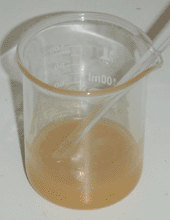
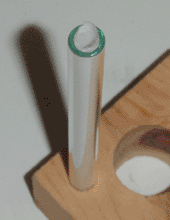
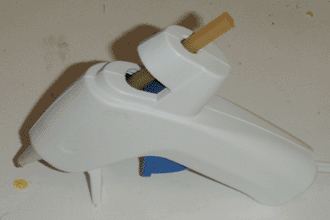
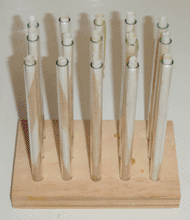
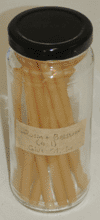
Molten pine rosin is extremely sticky, and this property has led to its use since prehistory as a general-purpose adhesive. It has an inherent limitation, however, in that it it becomes weak and brittle as it solidifies. To overcome this, a plasticizer must be added, and historically the most common material for this application was beeswax. Initially I was simply curious about the properties of this combination of materials, but early in my experimentation I discovered that it also had a practical application within my workshop.
I began by melting 20 grams of pine rosin in a small beaker, then observing its behavior as it cooled. As expected, it became glassy and brittle, readily chipping and turning into dust. I then added small amounts of beeswax at a time, repeating the melting and cooling process for each addition. At approximately 5% beeswax by weight, the rosin began to sound more like plastic than glass when tapped, but was otherwise unchanged. At 10%, the surface of the room-temperature rosin could be dented slightly, but the bulk of the material was still brittle. Finally, at 20%, the rosin had become significantly plastic, and would only fracture if struck sharply. At this point, I considered it adequate as a general-purpose glue. I used a glass stirring rod to drip it onto various surfaces, and it was able to bond wood, metal, and paper without issue.
Throughout this experimentation, I noticed that the behavior and viscosity of the rosin-beeswax mixture were nearly identical to that of ordinary hot glue. Furthermore, I found that it reached optimal fluidity at approximately 120°C, which is the exact operating temperature of common low-temperature glue guns. Out of curiosity, I purchased a small glue gun of this type for $3, and made a glue stick mold out of glass tubing and scrap wood, lining the glass with rolled parchment paper to prevent sticking. Making a glue stick this way was straightforward, although I did find it beneficial to refrigerate the mold after pouring to make the stick easier to remove.
Upon testing, the rosin glue behaved nearly identically to commercial glue sticks, with two slight differences. First, the glue had no tendency to form endless strings, and second, it was stiff rather than rubbery when cool. Both of these properties are attributable to the lack of polymer content, and I consider both to be improvements. The adhesion is equivalent to commercial glue, and the smell is significantly improved. In fact, the glue performed so well that I immediately made a larger set of molds and cast fifteen more glue sticks, just to have on hand. It is entirely possible that I will never use ordinary glue sticks again.
Although this glue is useful as-is, like many products based on natural materials, it is also fairly open-ended. Various additives can change the nature of the glue, making it more suitable for specific applications. Historically, two examples of this are cutler's resin (made by adding chalk or sawdust) and sealing wax (made by adding a dry pigment). Furthermore, the melting point of the glue can be modified by the type of resin and wax used, and the stiffness of the glue can be modified by the ratio of resin to wax. However, rather than exploring these options exhaustively, I intend to make them as needed for future projects.
Unfortunately, this glue is not stable in the long term, and within a year it loses most of its plasticity and becomes more difficult to melt. This happens even when kept in a sealed container, so it is likely due to a reaction between the beeswax and the rosin. This could possibly be resolved by using an excess of beeswax, or by using a less reactive resin such as shellac. In any case, this should be considered a strictly temporary adhesive unless the two objects being joined are totally rigid, and even then it should not be considered structural.
EDIT: 9/30/2023Further examination of my original batch of glue sticks revealed that my previous analysis was too hasty. While these sticks did become brittle and clog the glue gun, it was not for the reason I thought. Instead of the glue reacting with itself, it appears that the rosin component of the glue stick simply becomes oxidized over time to a depth of about 1mm. Below this layer, the glue remains intact and is still malleable after five years. This oxidized rosin has a higher melting point than its original form, which explains the clog; however, it can still eventually be melted and is compatible with the rest of the glue. Overall, while this glue is apparently unsuitable for use in a modern glue gun, it can still be used directly by applying heat to either the glue or the substrate.
Additionally, I have found that this glue can be pigmented (to make sealing wax) by first mixing the pigment with dry kaolin (or other clay) by shaking the two powders together in a jar, then stirring this mixture into a batch of molten glue. Dry clay readily absorbs oils and resins, so this method allows pigments to be mixed in without clumping. In general, this glue can hold approximately its own weight of clay as a filler, with the result being increased stiffness at the cost of reduced adhesion.
EDIT: 5/21/2025The brittleness described above (due to fracturing of the oxidized surface) can be avoided by simply increasing the wax content of the glue. Specifically, mixtures of wax and resin in a ratio of 1:1 to 1:3 by weight produce more mechanically durable adhesives, with the exact ratio determined by the desired level of plasticity. Additionally, higher-melting resins and waxes (such as dammar resin and carnauba wax) can be incorporated for better heat resistance, at the expense of flexibility.
For permanent applications however, a much more durable glue can be made from rosin and shellac, in a ratio of 1:1 to 1:3 by weight. Shellac alone is viscous and stringy when molten, and rapidly polymerizes if heated further to avoid this; however, rosin is a highly effective flux for other resins, and a small amount will render molten shellac fluid enough to be mixed and poured into molds. In fact, I have found it best to melt the rosin before adding the shellac, to minimize the degree of polymerization in the latter. This forms a hard and glossy adhesive with limited flexibility; however, it can be plasticized somewhat with castor oil, which can be mixed into the molten resins. This can be added at up to 10% of the weight of the shellac, in which it forms a solid solution. Further addition of oil tends to combine more with the rosin, and renders the glue permanently tacky. This oil can also serve as a carrier for pigments, which can be mulled into it similar to making oil paint. This pigmented glue is useful for decorative joints between any two materials, or can be applied to etchings and engravings on metal to color them, followed by wet-sanding to remove the excess and reheating to restore the glossy surface.
As this rosin-shellac glue has no surface tackiness when cold, it must be applied to heated substrates, and can be thought of as a type of solder for dissimilar materials. In fact, this property (of only sticking to hot surfaces) can be used to form buttons or sticks of glue, by pouring the molten mixture onto a cold sheet of metal and peeling it off once cooled. The exception is on porous and thermally insulative materials (such as wood or paper), where the heat of the glue is maintained long enough for it to wet into the surface. Interestingly, this glue also has the advantage of being easily cleaned from surfaces and equipment, as due to the lack of wax it is completely soluble in alcohol, acetone, and alkalis. It is, however, completely insoluble in turpentine and other oils due to the shellac content, which allows glue joints and colorful engravings to be polished along with the base materials without smearing the pigments.
Overall this new material appears to be highly useful, particularly for joining metal to either glass or wood, where it can serve as a replacement for modern epoxy. Its polymerization properties are interesting as well, and may yield practical applications as a thermosetting adhesive, or as a resin similar to bakelite. These and other uses will be developed further in later projects, however. For now it is simply an excellent glue.